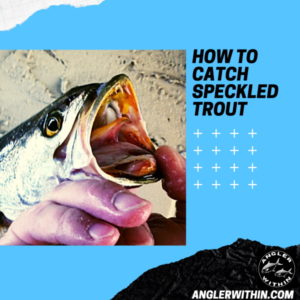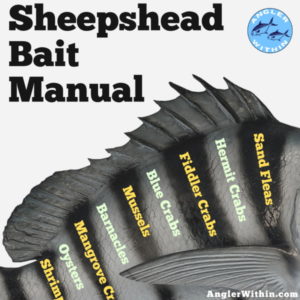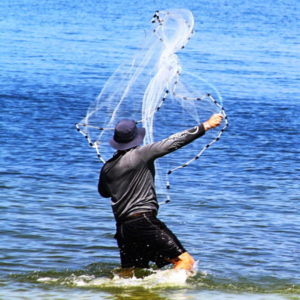
A “Pogie” is actually a “Gulf Menhaden” (Brevoortia patronus). Well, not so fast! I suppose it could also be an “Atlantic Menhaden” or even a “Yellowfin Menhaden”. Nevertheless, all 3 species of pogie found in Florida are great baits. One is not better than the other. These fish are commonly used when targeting many of the popular game species in Florida, so you’ll hear anglers refer to them often.
Some other terms used to refer to this most spectacular bait are Pogy, Pogies, Bunker, Fatback, Peanut Bunker, Shad, and Mossbunker. Some anglers even refer to them as “LY” which is very confusing, as L-Y is used to refer to a totally different fish along most of the Gulf Coast.
To recap, the term I hear used most often for menhaden in Florida is “Pogie”, not to be confused with “whitebait”. Honestly, I’m amazed at how often all these bait fish nicknames are used interchangeably and inconsistently in my part of the country. So, with the assumption that menhaden=pogie, let’s continue onward below.
About Them
Menhaden are an extremely important bait fish in the ecosystem for a variety of reasons. Most relevant to us is that they serve as a vital food source for many popular game species. When the menhaden are around, larger predators are sure to be close behind.
This bait is popular from south to north throughout the gulf as well as along the Atlantic coast. They will usually be sold frozen in most bait shops. Frozen chunks will work for many species, but as always, fresh is better. So, try to catch your own.
There is in fact 3 different species of menhaden (Gulf, Atlantic and Yellowfin) found in Florida, but as far as bait they are pretty well interchangeable.
Where To Find Menhaden In Florida

As the weather warms in May and June, menhaden move near the beaches and into the inlets and bayous. When they are really around, it can seem like they are everywhere.
The later it gets into the summer or early fall, the larger in size they get. They run in large schools and can often be seen flicking around near the surface. Schools of these “bunker” can be found hanging around inlets, piers, and bridges.
To locate a school, look for their flickering along the surface, and for birds, particularly pelicans, diving on them. They like to hang around mud bottoms and you can often locate them with a fish finder.
You can usually check in with the message boards and facebook groups local to your area to get a good idea of specific places to go check for them. Beware that sometimes a load of fresh water can push them out of where they previously were found.
How To Catch Pogies
Because pogies are filter feeders, you won’t be able to catch them consistently on a hook, no matter how small it is. Instead, you should cast net them.
Use a heavier, fast sinking net with larger mesh of 5/8″ or 3/4″. You can go with a smaller mesh earlier in the year when the bait are smaller. Move to 3/4″ when they get to be a larger size. An 8′ or 9′ net will do in shallower waters of less than 8′. In deeper water you may have to go with a larger net.
You’ll have more success when casting your net in low light conditions. So, early or late in the day is best. Identify flicking bait, move in close and throw your net over the movement. If your net sinks fast enough for the water depth you are in you shouldn’t have to make very many throws to get all the bait you need.
Really big pogies can also be snagged with weighted trebles, but that method is more common further North of Florida, where they tend to get larger.
Great Baits Indeed
Pogies are great for use as both dead bait and live bait, or even as chum. They are a very oily fish which makes them a very attractive bait, even when dead. You can freeze them for later use, however, fresh menhaden will stay on the hook better than previously frozen baits.
Like most bait fish, they are best fished alive. However, it can be difficult to keep this fragile bait alive. It’s very difficult to keep them lively in a bucket, even with an aerator. A large rounded baitwell in a boat works much better, but even that’s still not a sure thing. Regardless, as mentioned above, they do perform quite well even when dead.
They Appeal To A Wide Range Of Game Species
Menhaden are a commonly used bait fish for all sorts of species, such as redfish, king mackerel, grouper, speckled trout, spanish mackerel, snapper, snook, bluefish, cobia, sharks, and tarpon. As you can see their appeal is wide ranging.
How To Hook Them
There are a handful of ways to hook a menhaden for bait. If they are live, you obviously want to keep them that way. So, put the hook through the nose when casting towards sighted fish. You can also hook them all the normal live bait ways – top of the back, under the throat, or in the tail.
When fishing dead mehaden, cut them it into chunks and just be sure your hook point is plenty exposed. Hook the head portion through both lips.
You can either freeline the bait or send it to the bottom on a fish finder rig. Either method can be deadly.
Conclusion
Any time you hear the term “Pogie”, it almost always refers to menhaden, whether that be the Gulf or the Atlantic variety. With that said, there are many other names also used to refer to this extremely popular bait fish. Keeping all the nicknames for various bait fish straight can be quite a challenge for those new to a particular area.
If you found this helpful, and would also like to know what “whitebait” refers to, you can check that out here.
Good luck out there!
Augustus Clay



